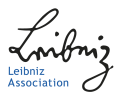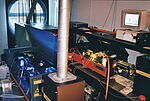The IAP metal lidars
The IAP metal lidar system is designed for the observation of layers of metal atoms in the upper mesosphere and lower thermosphere (roughly 75-140 km). The lidar utilizes resonant backscatter of the metal atoms after emission of laser radiation from two separately tunable dye lasers. The dye laser allows the easy change of the sounded metals.
Metal resonance lidars have been in operation at the IAP in Kühlungsborn since the mid-1990s. Most recently, the first successful soundings of nickel atoms were carried out and Li measurements were resumed after a hiatus of more than 40 years. Lithium is considered an indicator of anthropogenic influence on the middle atmosphere, as it is released during satellite re-entry and at the same time has a very low natural density. The original system is currently being replaced by a modern metal lidar, which will enable the simultaneous observation of three different species for the first time.
The detection system of the metal lidar uses a single 80-cm-mirror (focal length 3.2 m). The backscattered photons are guided by a glas fiber to a wavelength dependent mirror. Interference filters suppress the largest part of the background light before a photomultiplier detects the transmitted photons. The typical altitude resolution for the detection is 200 m (future: 1.5 m)
Selected Publications
- M. Gerding, R. Wing, W. Feng. J. M. C. Plane, G. Baumgarten, New Li lidar observations and model simulation: A window to anthropogenic signatures, Geophys. Res. Lett., August 2025, accepted, Preprint in ESS OpenArchive (DOI: 10.22541/essoar.175743022.28452149/v2)
- M. Gerding, S. Daly und J. M. C. Plane, Lidar soundings of the mesospheric nickel layer using Ni(3F) and Ni(3D) transitions, Geophys. Res. Lett., 46, 408-415, doi:10.1029/2018GL080701, 2019.
- J. M. C. Plane, S. M. Daly, W. Feng, M. Gerding und J. C. G. Martín, Meteor-ablated aluminum in the mesosphere-lower thermosphere, J. Geophys. Res., doi:10.1029/2020JA028792, 2021.













